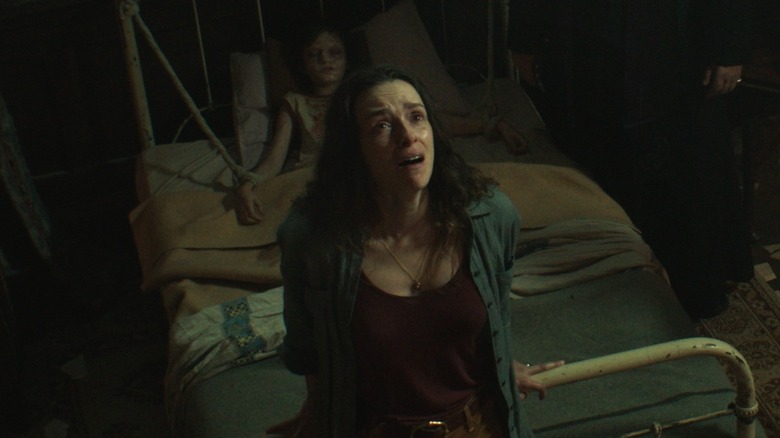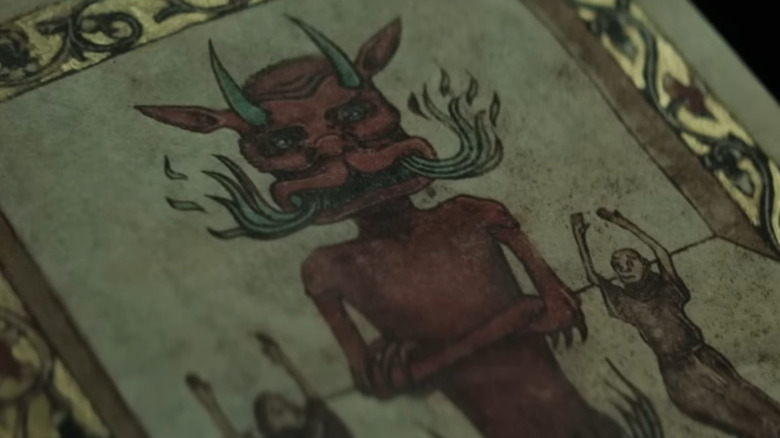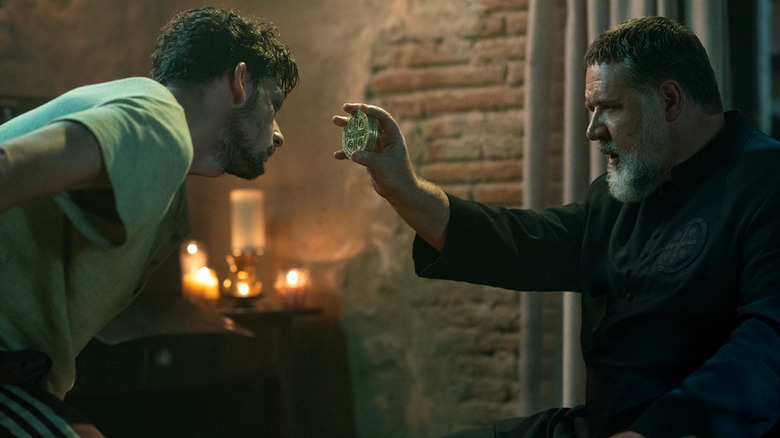The Ending Of The Pope's Exorcist Explained
Contains spoilers for "The Pope's Exorcist"
Prepare to experience an exorcism like no other. "The Pope's Exorcist" follows Father Gabriele Amorth (Russell Crowe), the Chief Exorcist for the Vatican, as he and Spanish priest Father Esquibel (Daniel Zovatto) help a young boy who is experiencing a sudden and rapidly escalating possession. What appears to be your run-of-the-mill possession turns into something more sinister as the inner workings of the Catholic Church are revealed and the face of the demon is brought to light.
The film takes audiences on the journey of a freshly minted Chief Exorcist as he grapples with his own convictions while trying to help a family before it's too late. Unlike many other possession-related films, the priest is the main character, not the family experiencing the possession. This provides a unique perspective on the life of the priest and how the church operates, which sets the film apart from others in its genre.
"The Pope's Exorcist" is inspired by the real events of Father Amorth, but that doesn't mean you know how it will end. Is Father Amorth successful in saving the boy? What happens to the demon causing the possession? What do we learn about the Chief Exorcist? Protect yourself and your soul as we venture into the abbey and share everything there is to know about the ending of "The Pope's Exorcist."
Father Gabriele Amorth forges a new path
Father Gabriele Amorth heads to Spain to help Henry Vasquez (Peter DeSouza-Feighoney), a young boy who is possessed after moving to an abandoned abbey. While trying to perform an exorcism and save Henry, the priest becomes possessed. After the Vasquez family is safely out of the house — demon-free — he goes into the catacombs beneath the abbey and, after a significant battle with the help of his colleague, forces the demon back into Hell.
The priest is not the same after his experience in the abbey. Audiences learn that he is remorseful for his role in a young girl's death by suicide. However, it isn't until the demon makes him relive that event that he confesses to God again. It's a reminder that, even if we initially confess or admit what we perceive to be mistakes in our lives, it sometimes takes another catalyst or significant event for the message to sink in, allowing us to realize its full impact.
Without this, Father Amorth's life may have continued to move in a different direction. He might have continued to overlook certain cases where he was needed, acting "prideful," as he calls it. Instead, he is helping the church research other locations that may have the same type of presence as the abbey that nearly claimed his life, and offering his services to those suffering from demonic possession.
Father Esquibel becomes the priest he's meant to be
Father Esquibel is the priest initially called as Henry's condition rapidly declines. However, he's the "wrong priest," as deemed by the demon possessing the boy. Over the course of the movie, we learn that he has had indiscretions and chose the priesthood over the love of his life, lying to her in the process. He is a timid individual who grows into his skin as a man of faith under the tutelage of Father Amorth.
While he struggles to resist the taunts and temptations the demon places in front of him, he overcomes his fear to make a difference and help Father Amorth survive his possession. It's a lesson that we are only as great at something as we allow ourselves to be. The priest could have allowed his timidness and weaknesses to prevent him from completing the exorcism. Instead, he finds strength in what he doesn't know and allows that to fuel him on his chosen path.
He demonstrates that sometimes we are the only person holding ourselves back. Father Amorth believed in the young man's ability to help with an exorcism and to protect the Vasquez family, even when the younger priest had doubts. While it took a pretty traumatic and intense event to help Father Esquibel reach his full potential, it is an important realization for him to have, especially considering what he chose to forego when he joined the church.
The Vasquez family recovers from the ordeal
The Vasquez family, consisting of widow Julia (Alex Essoe), teen Amy (Laurel Marsden), and tween Henry, move to Spain after the death of the family patriarch. The abbey had been in his family, and upon his death, they inherited the building. With no money and few options available to them, they move into the abbey with the plan to fix it up and sell it. After Henry's possession and exorcism, audiences are told that they move back to the United States and that Henry makes a complete recovery.
While the audience doesn't get to see them in that better place — the last time they're on screen is as they drive away — "The Pope's Exorcist" doesn't feel the need to devote screentime to their happy ending. Despite being the initial victims of the demon and being indirectly responsible for his return to the surface world, they aren't the focus of the story. Audiences don't need to see them in the United States for that closure; their driving away from the abbey in the car, everyone intact and alive, fulfills that purpose.
Some things don't necessarily need to be spelled out to audiences, and this is one of those cases. This can be a surprising rarity in film, where producers are constantly worried that viewers won't be able to keep up with the narrative, and this ending represents a welcome change.
What is the state of the San Sebastian Abbey?
When the Vasquezes move into the San Sebastian Abbey, it is run down, and they work to restore it while maintaining the original architectural features. However, with the events of the film, it still isn't in the best condition when the priests leave. The church effectively raids the property, rescuing the documents the two priests find in the catacombs below. They also reconsecrate the land in an effort to keep the demon back in Hell and prevent a similar situation from happening again.
The state of the property is symbolic of both the ending of the film and where the two priests end up after the exorcisms. Like the abbey, the priests made it to the other side, even though there was some damage inflicted along the way. For the priests, this comes in the form of both emotional and physical distress, but for the abbey it was only physical damage. But, also like the priests, the abbey stands tall. Despite the huge flames of gas and a demon literally trying to take over the church, it doesn't crumble under that pressure, and neither do Fathers Amorth and Esquibel.
Sometimes we have to experience pain to grow as people. The abbey will grow metaphorically with the church's intervention and the reconsecration, just like the priests did. Even though it won't be used as an abbey again, it has served an important purpose that will positively impact the church for years to come.
What is the state of Asmodeus?
Asmodeus, described as the King of Hell by Father Amorth, is the demon present within the San Sebastian Abbey. Unlike the demons seen in other exorcism films, Asmodeus is a powerful entity that completely changes the course of history in "The Pope's Exorcist." Fathers Amorth and Esquibel seem to successfully send the demon back to Hell in the final act, and the reconsecration of the land should provide an additional barrier to keep him from coming to the surface anytime soon.
Pushing and sealing Asmodeus back into Hell is an excellent representation of something we all do in our lives: compartmentalization. When we are experiencing emotions we aren't prepared to deal with, we section them off in our mind, isolating them until we are ready to go through them, just like how Henry went mute after the death of his father. Effectively, that's what the priests are doing. The church isn't prepared to deal with a demon of that power, so he is walled off until they have time to prepare.
However, they do take the time to go through the documents they gather from the abbey: Sometimes we need to do some work before we can approach intense emotions, especially ones that may be rooted in traumatic experiences. Even if it will take a long time — like the priests' quest to find the 100 other locations that contain similar portals to Hell — it's usually worth it.
Our pain can leave us vulnerable to more pain
There are several factors that lead to Henry's possession. While the construction is one of those factors, because it creates an opening in the physical barrier keeping the demon at bay, Henry's pain leaves him particularly vulnerable to demonic possession. He was in the car when his father died tragically, and that trauma had a significant impact on him. He becomes mute as he processes that, and has not spoken for an entire year. The young boy is still hurting, and moving to an unfamiliar place isn't helping his situation.
While on the drastic end of things, it's important to remember that sometimes, while trying to process pain, we actually leave ourselves more vulnerable. We can become so focused on trying to work through something that it can blind us to other situations that can hurt us. In Henry's case, this is an opening in his soul that Asmodeus takes advantage of.
A Latin phrase that translates to "our sins will seek us out" is repeated throughout the film, because of its use in the documents that discuss the history of the abbey. The phrase reminds us that someone will take advantage of our weaknesses if we let them. In this way, the demon takes advantage of Father Amorth's trauma and Henry's pain.
Trauma stays with us, no matter how much time has passed
While Henry's trauma is relatively fresh, having only witnessed the death of his father a year prior, Father Amorth's is older. We are introduced to his time at war, watching as his friends are killed by German soldiers and young Rosaria jumps to her death in front of him. Each incident took place at a different time in his life, but both still weigh on him heavily and impact his judgment and life.
Trauma doesn't automatically go away after a certain amount of time. Even years later we can feel intense emotions regarding a traumatic experience in our life. Seeing that depicted on screen is an important reminder of that not just for the general population, but for men in particular, whose mental health has not been prioritized in previous decades and has fewer depictions on screen.
Father Amorth almost looks ashamed that these events still weigh on him, and considers it a weakness that they can still be used against him by the demon. But he shouldn't be. There isn't a linear path to healing, and that is shown in how Henry copes with his father's passing and how Father Amorth remembers his time at war.
Sometimes we cover up what we are ashamed of
As the priests discover the history of the San Sebastian Abbey, they uncover that the last time Asmodeus walked in the human world, it was in the body of an important priest. This allowed the demon to infiltrate the church, ultimately leading to the Spanish Inquisition. What's worse is that the church knew that this happened, and handled it by walling the possessed priest away under the abbey and redacting all of the information from their records.
Anyone, even the organizations we believe in, can cover something up if they are ashamed of it. The church covered up what happened at the abbey because they were ashamed of the role they had in one of the most significant religious prosecutions in European history. They knew that what happened was wrong, and had to prevent the public from learning about it, as it would discredit the church if people knew.
But, "The Pope's Exorcist" makes sure to let us know that, even when you try to keep something a secret, it will always come to light sooner or later. In the case of the church, it takes hundreds of years, but the truth still eventually comes out. As we see in "The Pope's Exorcist," their secrets are revealed because the demon is uncaged, leading to more possessions taking place. If the church had been forthcoming about the history of the abbey, the possessions of Henry and Father Amorth could've been prevented.
Sometimes our demons come back to haunt us
Ultimately, "The Pope's Exorcist" made it clear that our demons will come back to haunt us. For Father Amorth, it is the memories and guilt over previous events in his life being used against him by a demon. For the church, it is an actual demon coming out of the abbey in which they confined it. For Father Esquibel, it's his previous indiscretions in relationships.
But the movie also reminds us we don't have to let those demons take over our life. Both priests fight against the past demons Asmodeus presents to them, not allowing themselves to become distracted from the task at hand by the imagery he forces on them. Though the demon possesses Father Amorth for the time being, he ultimately refuses to be haunted by the past any further.
While it may not seem like it at first, "The Pope's Exorcist" can be interpreted as a powerful message on how to handle your past trauma, the guilt over your past actions that can threaten to consume you, and how you can conquer those demons as you work through your pain over time. That is the journey Father Amorth goes through over the course of the film, as he performs these exorcisms.
Could we see Father Amorth again?
The movie is based on two books by Father Amorth, an actual exorcist. In his books, he describes his experience as an exorcist with the Roman Catholic church. Like other horror series, there is the potential to continue Father Amorth's story. "The Conjuring" franchise follows the case files of Ed and Lorraine Warren, two well-known paranormal investigators. Each film focuses on a different case from their body of files, like the Enfield poltergeist and the Amityville haunting.
"The Pope's Exorcist" takes place in 1987, just a single year into Amorth's tenure. There are plenty of other stories that can be told about the priest's life and his work: He conducted thousands of exorcisms over the course of his time with the church. The two books the film is based on, "An Exorcist Tells His Story" and "An Exorcist: More Stories," surely include other cases and information that could be adapted into another film.
Filmmakers could also show Father Amorth's journey as one of the founders of the International Association of Exorcists in 1990. Exorcisms are still contested in the public eye, and following the priest's journey of creating an organization for exorcists could provide a new angle in a genre that can sometimes struggle to be original.










